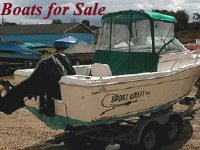|
Advanced Walleye Spinner Fishing
By
Keith Kavajecz and Gary Parsons
As we gear up for another greatly
anticipated walleye fishing season,
 everyone
is looking for that edge that will get them more bites. So what lures
are you stocking up on these days? Next to jigs, spinner style crawler
harnesses probably account for more walleyes than any other lure. They
should … after all they offer both attracting and triggering
characteristics that appeal to fish, and they are incredibly simple to
use. Categorized somewhere between a lure and terminal tackle, spinners
are made up of various combinations of hooks, beads, and blades threaded
on a monofilament leader. Alone, they don’t do much, but add a juicy
nightcrawler, minnow, leech or even a plastic trailer, run it behind a
bottom bouncer or other form of weighting system, and they become one of
the deadliest walleye presentations ever. everyone
is looking for that edge that will get them more bites. So what lures
are you stocking up on these days? Next to jigs, spinner style crawler
harnesses probably account for more walleyes than any other lure. They
should … after all they offer both attracting and triggering
characteristics that appeal to fish, and they are incredibly simple to
use. Categorized somewhere between a lure and terminal tackle, spinners
are made up of various combinations of hooks, beads, and blades threaded
on a monofilament leader. Alone, they don’t do much, but add a juicy
nightcrawler, minnow, leech or even a plastic trailer, run it behind a
bottom bouncer or other form of weighting system, and they become one of
the deadliest walleye presentations ever.
Spinners have been around for decades in various
forms, being fished for just about every species that swims. However,
the evolutionary strides this group of lures has taken, pushed by the
increased interest in walleye fishing the past few years, has been
astounding. As with so many innovations in modern walleye fishing,
experimentation by the rank and file fishermen as well as the efforts of
tournament anglers has rocketed spinner design and fishing techniques to
a new dimension of effectiveness. There have been some impressive
improvements since the days of wire-shafted June-Bug spinners and Dacron
line, and there’s no indication that we’ve reached the peak of this
design revolution yet.
Not so many years ago, spinner choices for the
walleye angler came down to a few key factors. If an angler wanted a
spinner with “flash”, he’d choose a blade with a metallic finish like
silver, copper, or gold. If color was more important to the spinner’s
success, then a myriad of painted blades could be selected from. It
wasn’t until a few years ago, when holographic blades came on the scene,
that color and flash were merged together to give anglers the ultimate
choice in spinner attraction. That innovation has sparked a revolution
in walleye spinners that has elevated this already popular tactic to the
forefront of walleye fishing.
The beauty of holographic finishes is that both
attracting attributes; flash and color, can be combined to make these
lures much more versatile. These blades can be used in a wide variety of
water conditions from gin-clear to very dirty. And the 3-dimensional
holographic finish lends itself to much more than just the spinner
blade. Working closely with Bass Pro Shops’ tackle designers, we
developed a line of hologram spinner components including not only
blades, but also spinner bodies. Instead of stringing together a number
of beads to separate the blade from the hooks, the XPS Walleye Angler
Blade Spacer is a foam body resembling a small baitfish featuring a
hologram finish. They come in six colors and two sizes to fit any
spinner application.
There was a time when the spinner was thought of as
strictly a presentation for use on structure, run behind a bottom
bouncer … no more! The open water fisheries of the Great Lakes have
proven to be dynamite spinner waters when the right components are put
to use. An open water spinner differs from a structure spinner in
several ways. The blades are typically bigger (sizes ranging from #4’s
to #6’s), treble hooks are often used in place of single hooks, and the
weighting systems used are designed more for targeting suspended fish
rather than bottom oriented walleyes. Off Shore Tackle Snap Weights have
been a popular weighting system for open water spinners since they first
made their way into the arsenals of big water walleye trollers. The
weights are affixed to a small clip which is attached to the line,
usually 25 to 50 feet in front of the spinner, after which additional
line is released until the lure reaches the preferred depth. An older
form of weighting system that has seen a resurgence over the past couple
of years among open water spinner trollers is the in-line weight. Often
referred to as “keel weights” or “bead-chain sinkers”, the popularity in
these weights led us to develop a set of weights for Bass Pro called the
XPS Walleye Angler Keel-Style Trolling Weights. Available in 3 sizes (1,
2 and 3 ounce), these weights are molded to resemble small baitfish,
feature the same holographic finish as the blades and bodies mentioned
earlier, and work “double-duty”, acting as not only a weighting system
but an attractor ahead of the spinner as well. So which weighting system
is best? You’ll have to let the walleyes tell
you. We've seen days when one way out produces the other, other days
when it was about fifty-fifty. We almost always start by running both
Snap Weights and in-line weights, and go with what ever presentation is
getting the most bites.
The flash and vibration of the blade along with the
scent of the bait combine to make spinners deadly walleye catchers.
Whether you apply them to fishing structure on small lakes, or trolling
the open waters on the Great Lakes, the advancements in spinner fishing
is sure to make big waves in your walleye catching success.
Editor's Note:
If you have questions or comments on this or other articles of ours you
may have read, contact us through our website at
www.thenextbite.com.
|






 everyone
is looking for that edge that will get them more bites. So what lures
are you stocking up on these days? Next to jigs, spinner style crawler
harnesses probably account for more walleyes than any other lure. They
should … after all they offer both attracting and triggering
characteristics that appeal to fish, and they are incredibly simple to
use. Categorized somewhere between a lure and terminal tackle, spinners
are made up of various combinations of hooks, beads, and blades threaded
on a monofilament leader. Alone, they don’t do much, but add a juicy
nightcrawler, minnow, leech or even a plastic trailer, run it behind a
bottom bouncer or other form of weighting system, and they become one of
the deadliest walleye presentations ever.
everyone
is looking for that edge that will get them more bites. So what lures
are you stocking up on these days? Next to jigs, spinner style crawler
harnesses probably account for more walleyes than any other lure. They
should … after all they offer both attracting and triggering
characteristics that appeal to fish, and they are incredibly simple to
use. Categorized somewhere between a lure and terminal tackle, spinners
are made up of various combinations of hooks, beads, and blades threaded
on a monofilament leader. Alone, they don’t do much, but add a juicy
nightcrawler, minnow, leech or even a plastic trailer, run it behind a
bottom bouncer or other form of weighting system, and they become one of
the deadliest walleye presentations ever.